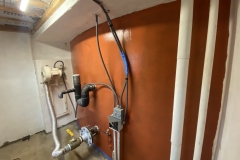
From January 16-27 the SAM construction team continued to check off tasks, one by one. With the bathroom platform (originally built in April 2022) reinstalled, and the hole drilled for the toilet outlet, the waste water storage tank was adjusted to its final position and secured, the inlet and vent openings cut and rubber flanges installed.
Construction of the bathroom walls was conducted from the shower stall to the door and then far wall, each section building upon the prior for both placement and stability. With very limited space (even if luxurious by NASA standards), every fraction of an inch had to be just right, literally built around the shower basin on three sides while leaving room for the plumbing that will be the 100% recycled water system with small water storage, pump, and filters.
Two significant challenges emerged: building a sturdy, essentially self-stabilized bathroom box within the 40′ shipping container without penetrating the walls, as a screw or rivet could introduce a leak point behind a structural member we’d never be able to reach again; and minimizing condensation formed at the interface of warm, moist air (from the shower) and the cool, interior metal lining of the 40′ shipping container in the winter months. We decided to enclose the top of the shower to reduce condensation and to give us an overhead surface on which we can mount a water storage tank, pump, and/or filter.
The steel bathroom door was reduced in height to match the vertical dimension of the crew quarters-to-workshop bridge. This required a rebuild of both the top and bottom, and total refabrication of the door jam itself. The end result is beautiful and strong, with interlaced, laminated joints. The bathroom has been a work in progress since the start of 2023, and will surely require a few more, but it will be well worth the effort when complete.
We chose colors from the SIMOC-SAM logo to hi-light a few exterior elements of the physical SAM structure, including the lower, outer lung wall and the outer entrance to the Test Module. Sean continued his critical work in revitalizing the three pressure doors, all original to the Biosphere 2 experiments of the 90s. This included multiple applications of PB Blaster, a steel brush, and bucket of soapy water.
In addition to the physical work at SAM, critical components and key appliances were ordered, including the electric actuated valve control the SAM AIR blower, convection microwave oven, bread maker, rice cooker, and water filters. A WiFi hotspot will provide internet for the first mission until a narrow-beam transceiver is in place, providing dedicated, point-to-point communication from Mission Control to SAM itself. The SAM internet and email server is ordered and on its way, with a very unique means to simulate the light travel-time delay developed just for SAM.


